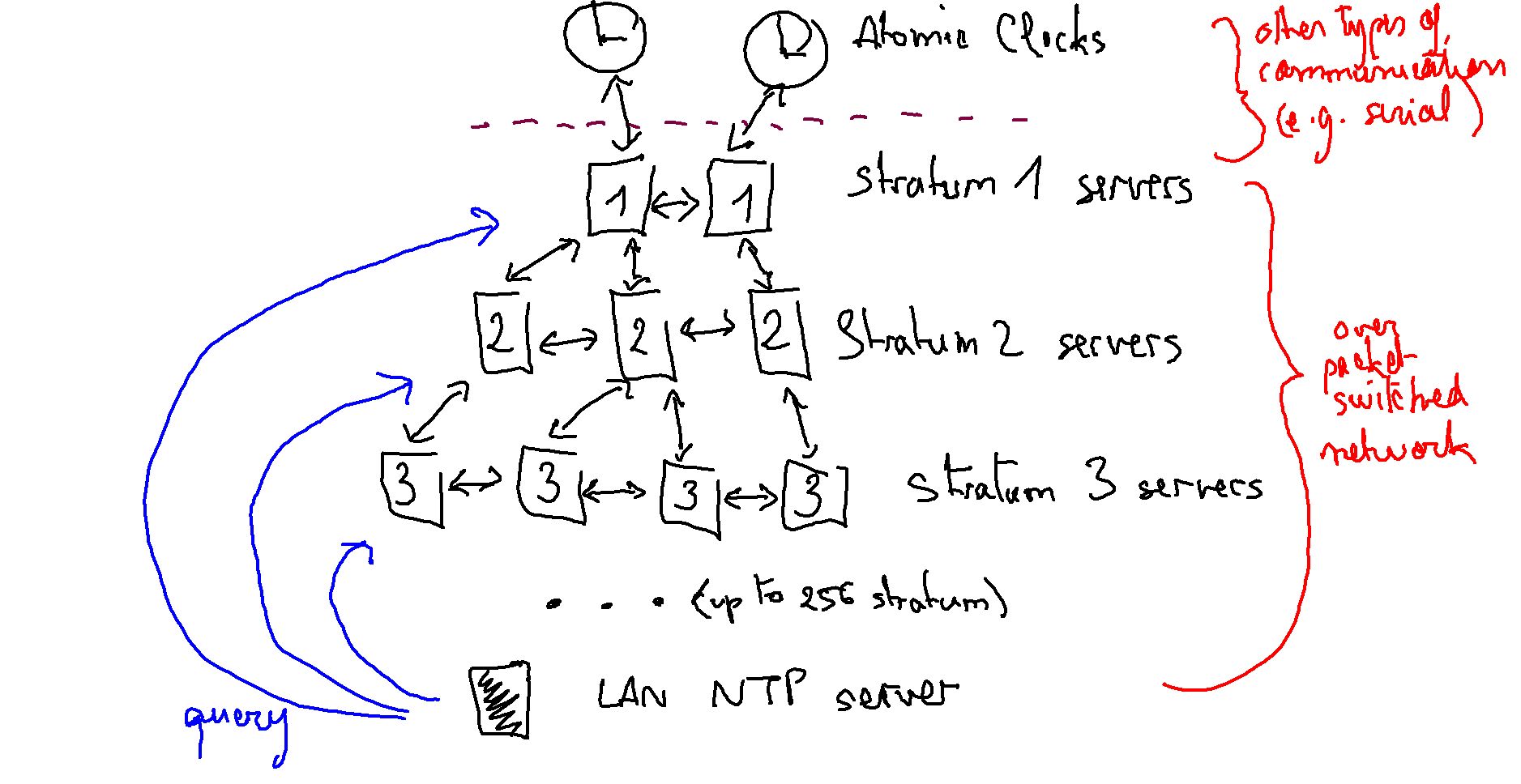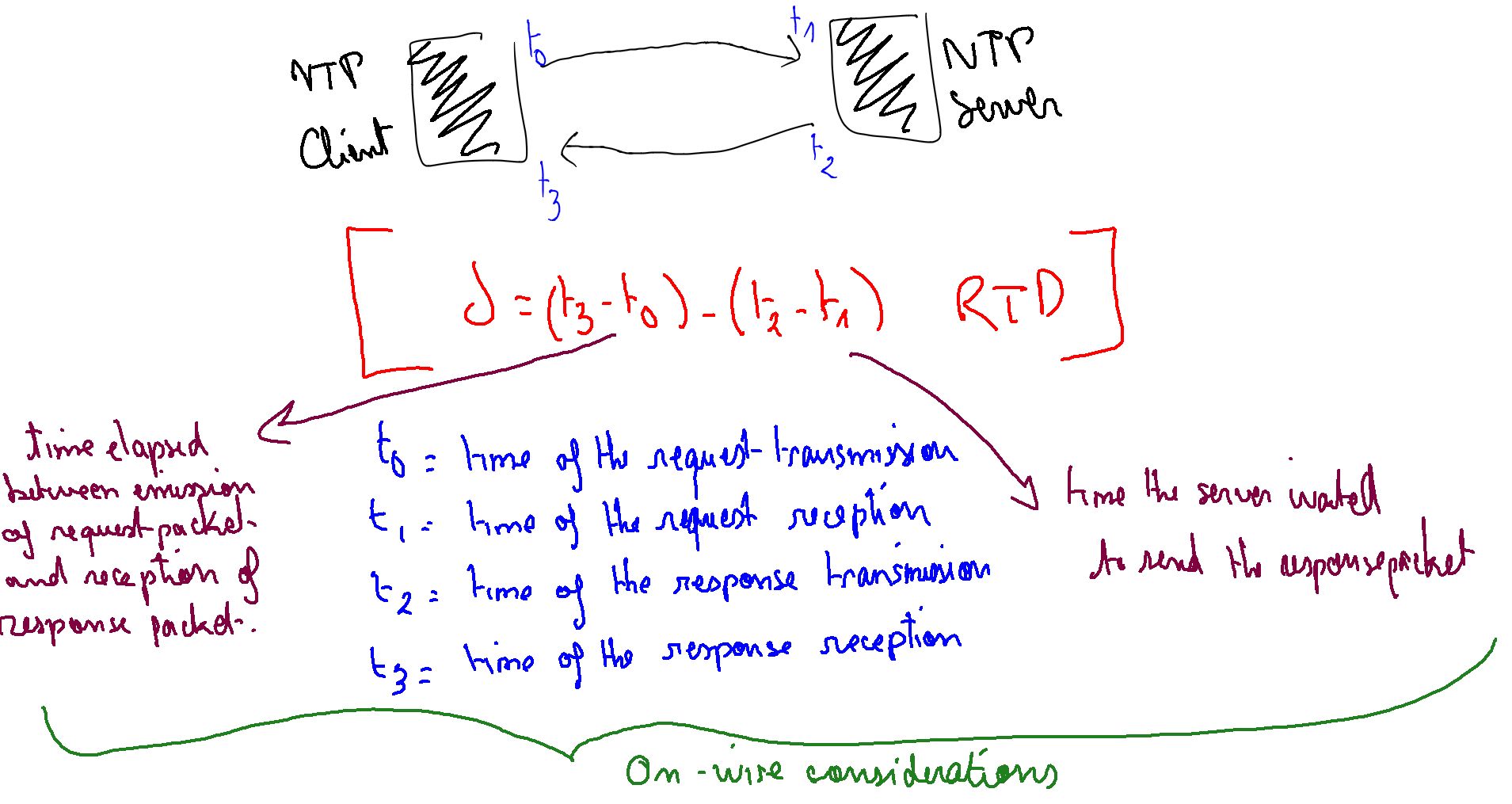Network Time Protocol Lab
Why guarantee time synchronization across your network ?
Time synchronization is very important in an IT environment . Firstly because it ensures that all employees and their devices (computers, phones…) have all the same time. Secondly because the operating systems and network devices must be synchronized for security reason: when you analyze and correlate log information, timestamps are very precious.
NTP Protocol
NTP stands for Network Time Protocol. The current version number is 4. This protocol will get the time from an external time source and will propagate it in the local area network. To retrieve the time, NTP will request high stratum time servers. Strata are a hierarchical division of time servers. Strata represent the distance from the time server in term of accuracy. For example, Stratum 0 is the most accurate time resource (it is composed of atomic clock, satellites…). As we cannot ask directly stratum 0 devices, Stratum 1 is the most accurate time source. Stratum 1 is composed of servers directly attached to atomic clocks. Then you have stratum 2 servers querying stratum 1 servers and stratum 3 servers querying stratum 2 servers, and so on so forth.
You can get a list of available time servers for you time zone at http://www.pool.ntp.org/zone/us or at http://support.ntp.org/bin/view/Servers/StratumOneTimeServers".

To ensure client-server synchronization, NTP uses a round-trip delay time mechanism to calculate the time the request spend on the wire and the time it take to process it http://en.wikipedia.org/wiki/Round-trip_delay_time.
Because a picture is worth a thousand words:

For those who want to go further, follow this interesting link: http://www.isi.edu/touch/pubs/mirage/ch4.pdf
Note that NTP is sending UTC time (Coordinated Universal Time).
NTPd
NTPd is the traditional NTP daemon on Linux systems. NTPd is used for both server and client use. For openBSD, you can get openNTPd http://www.openntpd.org.
In the following article I detail the configuration of a NTP server and client running Debian Linux operating system.
NTP operation modes
- Symmetric active: the server sends NTP updates to its clients or to other servers periodically. It actively provides synchronization and could also be synchronized.
- Symmetric passive: a server in this mode waits a NTP message before synchronizing clients or being synchronized.
- client: in this mode, a server or a workstation periodically sends messages to be synchronized.
- server: this mode is activated on a server when a NTP client message is received
- broadcast/multicast: used in local area network to provide time for the clients
- manycast: used in redundant / complex scenarios (clients and servers use multicast and unicast messages, http://www.eecis.udel.edu/~mills/autocfg.html
Server configuration
# cp /etc/ntp.conf /etc/ntp.conf.bak
# vim /etc/ntp.conf
driftfile /var/lib/ntp/ntp.drift
# Enable this if you want statistics to be logged.
statsdir /var/log/ntpstats/
statistics loopstats peerstats clockstats
filegen loopstats file loopstats type day enable
filegen peerstats file peerstats type day enable
filegen clockstats file clockstats type day enable
# You do need to talk to an NTP server or two (or three).
#server ntp.your-provider.example
## Stratum 1 servers
server nist1-la.WiTime.net
## Stratum 2 servers
server ac-ntp1.net.cmu.edu
server ac-ntp0.net.cmu.edu
# pool.ntp.org maps to about 1000 low-stratum NTP servers. Your server will
# pick a different set every time it starts up. Please consider joining the
# pool:
# server 0.north-america.pool.ntp.org iburst
# server 1.north-america.pool.ntp.org iburst
# server 2.north-america.pool.ntp.org iburst
# server 3.north-america.pool.ntp.org iburst
# Access control configuration; see /usr/share/doc/ntp-doc/html/accopt.html for
# details. The web page
# might also be helpful.
#
# Note that "restrict" applies to both servers and clients, so a configuration
# that might be intended to block requests from certain clients could also end
# up blocking replies from your own upstream servers.
# By default, exchange time with everybody, but don't allow configuration.
# restrict default ignore ? forbid access for everyone, you need to add each server
# manually
restrict -4 default kod notrap nomodify nopeer noquery
restrict -6 default kod notrap nomodify nopeer noquery
# Local users may interrogate the ntp server more closely.
restrict 127.0.0.1
restrict ::1
# Clients from this (example!) subnet have unlimited access, but only if
# cryptographically authenticated.
#restrict 192.168.123.0 mask 255.255.255.0 notrust
restrict 192.168.2.0 mask 255.255.255.0 nomodify notrap
# If you want to provide time to your local subnet, change the next line.
# (Again, the address is an example only.)
#broadcast 192.168.2.0
# If you want to listen to time broadcasts on your local subnet, de-comment the
# next lines. Please do this only if you trust everybody on the network!
#disable auth
#broadcastclient
Do not forget to set the timezone (NTP sends UTC time!)
# ln -s /usr/share/zoneinfo/Americas/New_York /etc/localtime
or
# tzselect
Start the service:
# /etc/init.d/ntp restart
Verify:
==============================================================================
64.147.116.229 .ACTS. 1 u 1 64 1 169.365 -101.47 0.000
AC-NTP1.NET.CMU 128.237.148.140 2 u 4 64 1 142.434 -109.43 0.000
AC-NTP0.NET.CMU 128.237.148.140 2 u 3 64 1 142.474 -110.73 0.000
- remote: address / domain name of the peer
- refid: what is your peer time source (another NTP server or an internal clock, here ACTS means Automated Computer Time Service
- st: stratum
- t: type of the relation (unicast, broadcast, multicast, local)
- when: when the peer was last heard (seconds)
- poll: polling interval (seconds)
- reach: status of the reachability
- delay: latest delay in milliseconds
- offset: latest offset in milliseconds
- jitter: latest jitter in milliseconds
Client configuration
Linux
Installation commands :
# aptitude install ntp ntpdate
# service ntp stop
# ntpdate –u 192.168.2.106
# service ntp start
# date
Cisco IOS
R1(config)#ntp ?
access-group Control NTP access
authenticate Authenticate time sources
authentication-key Authentication key for trusted time sources
broadcastdelay Estimated round-trip delay
clock-period Length of hardware clock tick
logging Enable NTP message logging
master Act as NTP master clock
max-associations Set maximum number of associations
peer Configure NTP peer
server Configure NTP server
source Configure interface for source address
trusted-key Key numbers for trusted time sources
R1(config)#ntp server 192.168.2.106 version 3 prefer
R1(config)#ntp source fastEthernet 0/0
R1(config)#ntp logging
R1#show ntp associations
address ref clock st when poll reach delay offset disp
*~192.168.2.106 64.147.116.229 2 56 64 1 12.1 50.91 15875.
* master (synced), # master (unsynced), + selected, - candidate, ~ configured
R1#show ntp status
Clock is synchronized, stratum 3, reference is 192.168.2.106
nominal freq is 250.0000 Hz, actual freq is 250.0000 Hz, precision is 2**18
reference time is D4495700.41E7C0D7 (22:43:12.257 UTC Sat Nov 10 2012)
clock offset is 50.9131 msec, root delay is 181.38 msec
root dispersion is 16492.39 msec, peer dispersion is 15875.02 msec
R1#show ntp associations detail
192.168.2.106 configured, our_master, sane, valid, stratum 2
ref ID 64.147.116.229, time D4495687.73B8E54A (22:41:11.452 UTC Sat Nov 10 2012)
our mode client, peer mode server, our poll intvl 64, peer poll intvl 64
root delay 169.28 msec, root disp 566.47, reach 2, sync dist 16532.166
delay 12.10 msec, offset 50.9131 msec, dispersion 15875.02
precision 2**23, version 3
org time D4495740.545E93BB (22:44:16.329 UTC Sat Nov 10 2012)
rcv time D4495740.4A0E1B51 (22:44:16.289 UTC Sat Nov 10 2012)
xmt time D4495740.46ED4678 (22:44:16.277 UTC Sat Nov 10 2012)
filtdelay = 12.10 0.00 0.00 0.00 0.00 0.00 0.00 0.00
filtoffset = 50.91 0.00 0.00 0.00 0.00 0.00 0.00 0.00
filterror = 0.02 16000.0 16000.0 16000.0 16000.0 16000.0 16000.0 16000.0
R1#debug ntp events
NTP events debugging is on
Mar 1 00:33:22.135: NTP: 192.168.2.106 reachable
Mar 1 00:33:22.135: %NTP-6-PEERREACH: Peer 192.168.2.106 is reachable
Nov 10 22:42:08.273: %SYS-6-CLOCKUPDATE: System clock has been updated from 00:35:30 UTC Fri Mar 1 2002 to 22:42:08 UTC Sat Nov 10 2012, configured from NTP by 192.168.2.106.
Nov 10 22:42:08.273: NTP: peer stratum change
Nov 10 22:42:08.273: NTP: clock reset
Nov 10 22:43:12.257: NTP: 192.168.2.106 synced to new peer
Nov 10 22:43:12.261: %NTP-5-PEERSYNC: NTP synced to peer 192.168.2.106
Nov 10 22:43:12.261: NTP: sync change
Nov 10 22:43:12.261: NTP: peer stratum change
Nov 10 22:43:12.261: NTP: 192.168.2.106 reachable
Nov 10 22:43:12.261: %NTP-6-PEERREACH: Peer 192.168.2.106 is reachable
Juniper JunOS
# edit system ntp
[edit system ntp]
# set ?
Possible completions:
+ apply-groups Groups from which to inherit configuration data
+ apply-groups-except Don't inherit configuration data from these groups
> authentication-key Authentication key information
boot-server Server to query during boot sequence
> broadcast Broadcast parameters
broadcast-client Listen to broadcast NTP
> multicast-client Listen to multicast NTP
> peer Peer parameters
> server Server parameters
source-address Use specified address as source address
+ trusted-key List of trusted authentication keys
[edit system ntp]
# set server 192.168.2.106
[edit system ntp]
> show ntp ?
Possible completions:
associations Show status of peers
status Show internal variables returned by peers
Caveats If there is too much delay between your time source and your server, it might raise an error saying that it cannot synchronize. It is advised not to set a stratum 1 or stratum 2 time source.
Links
NTP version 4 RFCs :
- RFC 5905: Network Time Protocol Version 4: Protocol and Algorithms Specification
- RFC 5906: Network Time Protocol Version 4: Autokey Specification
- RFC 5907: Definitions of Managed Objects for Network Time Protocol Version 4 (NTPv4)
- RFC 5908: Network Time Protocol (NTP) Server Option for DHCPv6
NTP version 3 RFCs :
- RFC 1305: Network Time Protocol (Version 3) Specification, Implementation and Analysis
Other links :
- http://en.wikipedia.org/wiki/Network_Time_Protocol
- http://doc.ntp.org/3-5.93e/debug.html
- http://stack.nil.com/ipcorner/BeOnTime/
- http://www.ntp.org/
- http://wiki.debian.org/NTP
- http://www.eecis.udel.edu/~mills/ntp/html/ntpd.html
- http://www.linuxhomenetworking.com/wiki/index.php/Quick_HOWTO_:Ch24:_The_NTP_Server
- http://support.ntp.org/bin/view/Servers/StratumOneTimeServers
- http://support.ntp.org/bin/view/Servers/StratumTwoTimeServers
- http://www.pool.ntp.org/zone/us
- http://www.freebsd.org/doc/fr/books/handbook/network-ntp.html
- http://www.eecis.udel.edu/~mills/ntp/html/ntpdate.html
- http://www.openntpd.org/
- http://linux.die.net/man/8/ntpd
- http://www.ntp.org/ntpfaq/NTP-s-algo.htm
- http://www.isi.edu/touch/pubs/mirage/ch4.pdf
- https://www.juniper.net/techpubs/en_US/junos/topics/reference/command-summary/show-ntp-associations.html